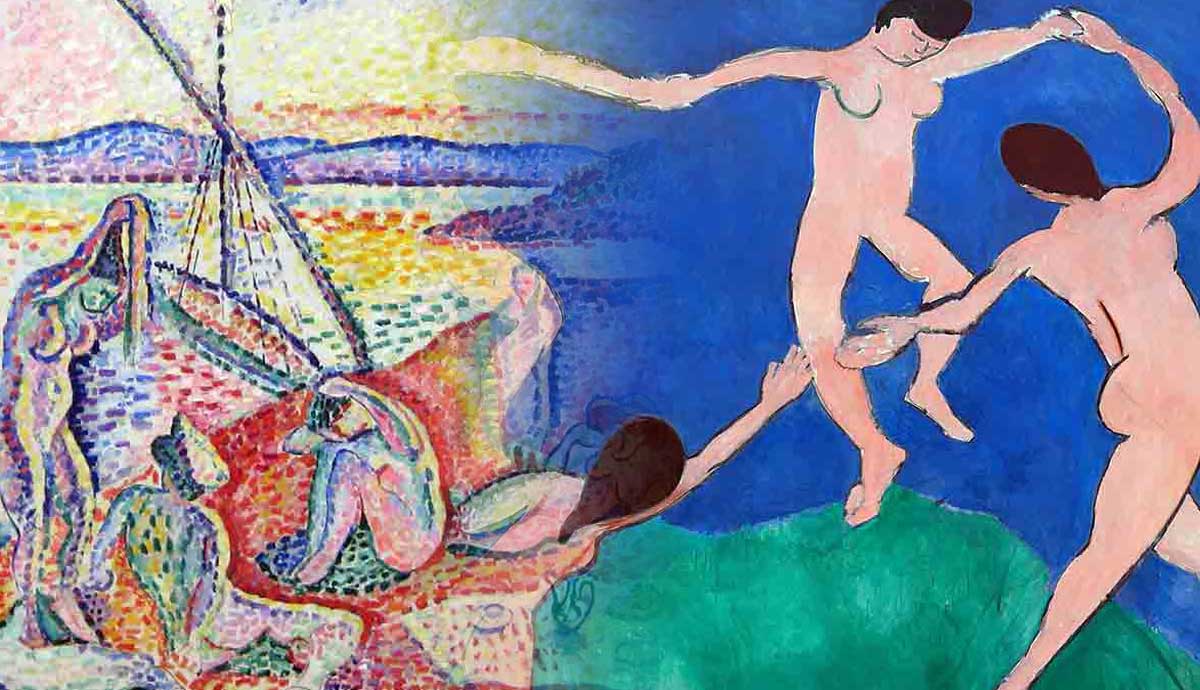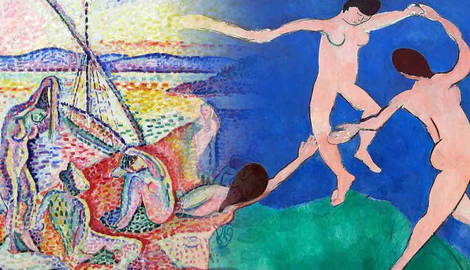
Known for his iconic use of vivid colors, Henri Matisse was always on the move. From the early stages of his artistic career, the painter was fueled by a passion for new and foreign places. Therefore, Henri Matisse’s extensive travels to various cities and countries left a significant mark on his art. The South of France, in particular, emerged as the most influential place in his career. Here, Matisse liberated himself from the constraints of traditional art and began experimenting with color.
1. Belle-Île, Brittany: The First of Henri Matisse’s Travels

Belle-Île is an island located off the coast of Brittany, a peninsula in northwestern France. On one side, the island features extremely sharp cliff edges, while on the other side, it is covered in beaches. Despite its milder weather compared to other northern regions in France, Henri Matisse couldn’t escape the climate of the North. Although the time he spent in Brittany cannot be equated to his vacation in Corsica in terms of his feeling of belonging, it marked a significant turning point in his development as an artist.
Matisse and Camille Joblaud, his girlfriend at the time, visited Brittany after receiving an invitation from John Russell, an Australian impressionist painter who lived on the island. It was Russell who introduced Matisse to the Impressionist theories on light and color. At that point, Matisse’s art changed completely. Before Matisse’s trip to Belle-Île, his color palette was dull and dark. In Brittany, he started using bright colors and abruptly changed his style to resemble that of Impressionism. The young French painter became obsessed with Claude Monet. He was also interested in Vincent van Gogh’s art and in Paul Cezanne’s use of perspective. Although Matisse worked on a few paintings in the Impressionist style, he later changed his stylistic approach using brighter colors, rarely painting en plein air.
2. Ajaccio, Corsica

On the west coast of Corsica lies Ajaccio, a city hidden at the foot of wooded hills surrounded by picturesque beaches. The region boasts a Mediterranean climate with almost twice as much sunshine as Paris. However, it wasn’t just the climate that impressed Matisse. The people in the South were very different from those in the North. The young painter discovered simplicity, warmth, generosity, and acceptance while there. In Ajaccio, Matisse was captivated by the southern light, which opened numerous artistic doors for him. Matisse also loved the vegetation of the south. There were palm trees, olive trees, cactuses, and agave plants. Matisse and his wife, Amélie, stayed here for five months, during which he painted more than 50 canvases.
3. Saint-Tropez and Paul Signac’s Technique

Another destination that marked a turning point in Matisse’s career was Saint-Tropez. Saint-Tropez welcomed the Matisse family in 1904. At the time, it was a quiet fishing village located on the French Riviera. Thanks to Paul Signac, Matisse returned home with a new perspective. Over the years, Signac, a Pointillist painter residing in Saint-Tropez since 1892, invited other artists like Georges Braque and Henri-Edmond Cross to join him.
When Matisse arrived in the small village in 1904, he was already familiar with Signac’s work. A few years earlier, he had read Signac’s essay on Neo-Impressionism and even tried the technique himself. However, after witnessing Signac’s paintings in Saint-Tropez, Matisse revisited Divisionism in 1904 and he finally found freedom of expression. A painting executed by Matisse using the Divisionist technique after his return from Saint-Tropez titled Luxe, Calme et Volupté is now widely recognized as the starting point of Fauvism
4. Collioure and the Explosion of Colors

Situated in southern France, the small town of Collioure marked the country’s closest point to North Africa. This quiet city was adorned with banana, orange, and lemon trees, fig plants, as well as pomegranate and cherry trees that blossomed beautifully. The town was filled with extraordinary lights and colors. In May 1905, Matisse arrived in Collioure, and the seaport quickly felt like home to him. From his bedroom window, he had a view of the port, and he spent his days observing the working fishermen.

During the time spent in Collioure, Matisse felt comfortable enough to experiment with vibrant colors applied in small brushstrokes. What he experienced in Collioure led to an awakening and his biggest artistic transformation yet. A year later, Henri Matisse exhibited his famous work The Joy of Life at the 1906 Salon des Indépendants. Another masterpiece that was a product of Matisse’s impression of Collioure is his Dance, the famous painting depicting five dancing figures against a green-blue background. The actual dance depicted here was a traditional Catalan dance called Sardana, which Matisse saw in Collioure. If you look closely, you will notice the same dancing group in The Joy of Life too.
5. Biskra, Algeria

Lying in northeastern Algeria, the city of Biskra is also known as The Queen of the Zibans and the Saharan Nice. In the late 19th century, Biskra became a favorite destination among artists. Matisse arrived here in the spring of 1906. Initially, his impression of Algeria was not positive and he described the place as filthy. However, he later developed a deep affection for Biskra, stating that the oasis was indeed beautiful. Apart from its captivating landscape, Biskra was renowned for its carpets made in a myriad of colors. The artist’s connection to textiles began in his birthplace, Bohain, which was once a major center for the textile industry. Growing up surrounded by textiles, Biskra’s collection of carpets proved truly fascinating for Matisse.

Although Matisse did not paint a lot during his stay in Biskra, the memories of his trip to Algeria later inspired the creation of several iconic artworks. Among those, the most famous one is Blue Nude (Souvenir of Biskra) from 1907. This painting, characterized by visible brushstrokes and vivid, unrealistic colors that defy academic art rules, shows a female nude with unconventional characteristics. The model’s muscular anatomy deviates from the conventional depictions that were familiar to viewers at the time.
6. Tangier, Morocco

Situated in northwestern Morocco, Tangier sprawls along the coasts of both the Mediterranean Sea and the Atlantic Ocean. Matisse first visited Morocco in 1912, and he was immediately struck by the country’s distinctiveness. The works executed that year, along with later paintings, feature many African motifs. During his time in Tangier, Matisse met Zorah, his favorite Moroccan model, who posed for numerous paintings in various outfits and positions. This journey ignited Matisse’s fascination with the female figure in the 1920s, resulting in the creation of numerous odalisque paintings. Tangier profoundly influenced Matisse’s work, however, infusing it with a dose of Orientalism.
Not everyone has enjoyed these works. Najwa Ali, in an article about Matisse’s odalisques, comments that “There are massacres–somewhere outside the frame. Matisse complains only of weather. Paints flowers obsessively and sometimes Zohra, the local girl, maid, prostitute, whatever. Zohra.” According to John Ederfield, Matisse’s goal was not to focus the viewers’ attention on the female body. Instead, he filled the canvases with complex backgrounds that stop us from looking at the subjects. He states that Matisse “prevents our staring: dissolves the strength of our gaze. When vision is emphasized in pictorial images, it is experienced as a sexual activity; a singularly destructive one.” According to him, Matisse de-emphasizes vision.
7. Tahiti: Henri Matisse’s Trip That Had a Lasting Impact

Nestled in the central part of the Pacific Ocean, Tahiti is the largest of the Windward Islands. It boasts a diverse landscape featuring mountains, volcanoes, rainforests, rivers, and waterfalls. In 1930, Matisse embarked on his journey to Tahiti, seeking inspiration from the tropical light reminiscent of what he had found in the south of France. Despite his deep appreciation for the island, Matisse did not find significant inspiration during his stay. However, his impressions of Tahiti began to resurface in his later works.
After the beginning of World War II, Matisse’s health started deteriorating. He had to undergo surgery that nearly killed him and left him bedridden for a very long time. Because of this, he could not paint as fervently as before. During this time, Matisse revived his passion for cutouts. In 1946, he created a series of four mural-sized works inspired by his tropical journey: Polynesia the Sea, Polynesia the Sky, Oceania the Sea, and Oceania the Sky. Eleven years before that, in 1935, he painted Window in Tahiti, so this was not the first time Matisse materialized his old impressions of Tahiti.










